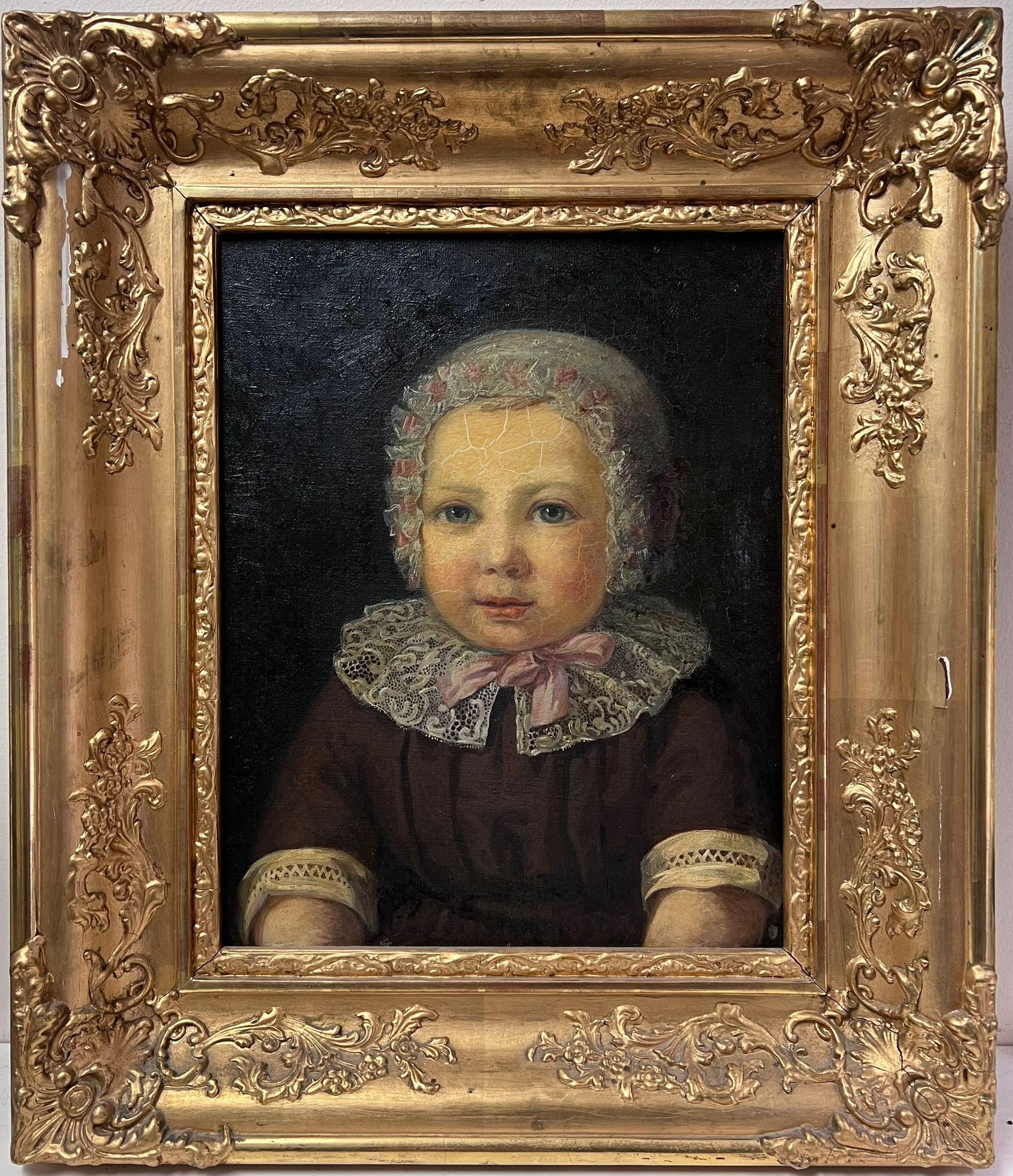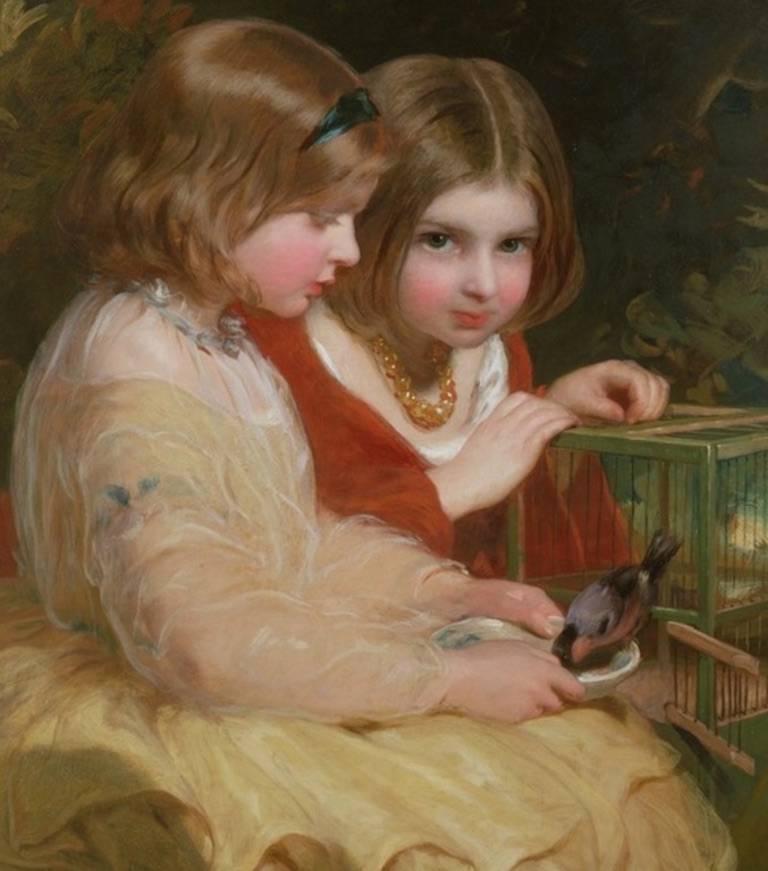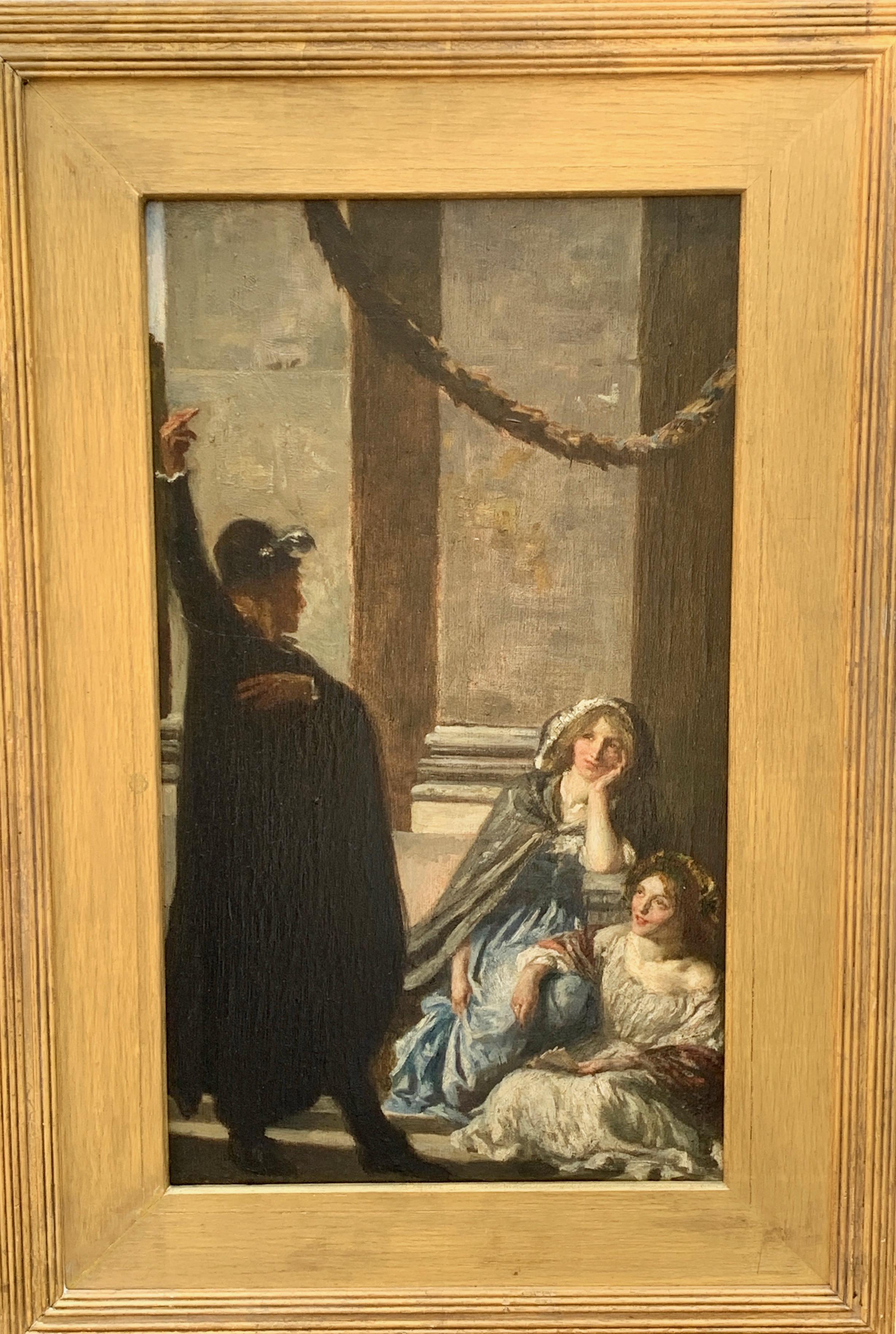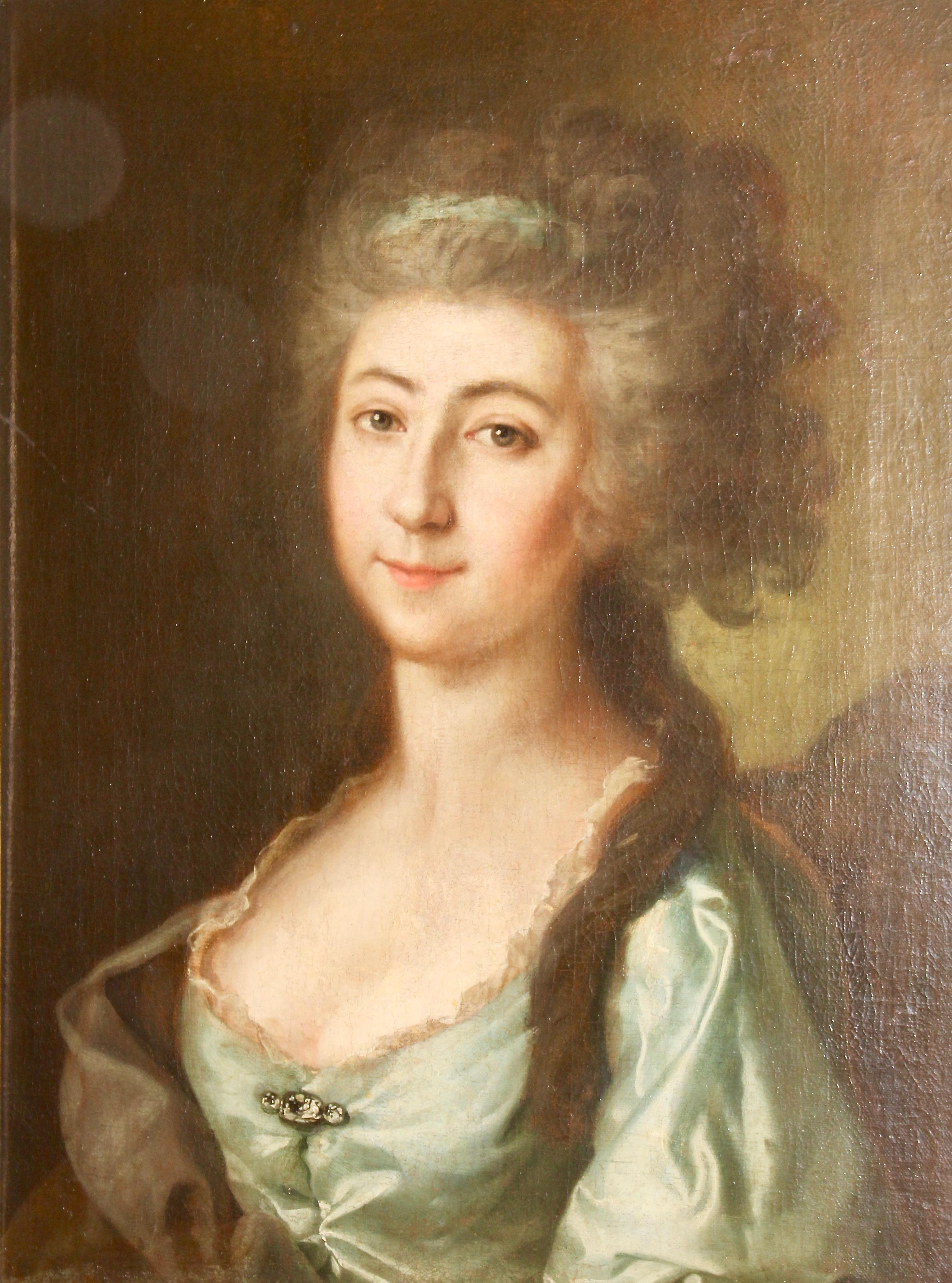Items Similar to The Gossip - Scottish 19thC art Victorian oil painting young romantic couple
Want more images or videos?
Request additional images or videos from the seller
1 of 14
William Fettes DouglasThe Gossip - Scottish 19thC art Victorian oil painting young romantic couple1868
1868
About the Item
A fine Victorian Scottish genre oil on canvas painting which dates to 1868 and is titled The Gossip by famous Scottish artist William Fettes Douglas RSA. It is a stunning depiction of a courting couple in very good condition. It is a very evocative genre painting and a fine period oil painting. Douglas is a highly sought-after genre artist whose paintings are listed in the auction catalogues to many thousands GBP.
Signed upper right.
Provenance. Scottish estate.
Condition. Oil on canvas, 18 inches by 15 inches unframed and in excellent condition.
Housed in a fine frame 26 by 23 inches framed and in good condition.
Sir William Fettes Douglas (1822–1891) was a Scottish painter and art connoisseur, rising to be President of the Royal Scottish Academy. He was the eldest son of James Douglas and Martha Brook, grandniece of Sir William Fettes, bart., the founder of Fettes College. He was born on 12 March 1822 in Edinburgh. On the completion of his education at the High School of Edinburgh, he entered the Commercial Bank of Scotland, in which his father was accountant. However, the elder Douglas was an amateur of some talent, and the son devoted the leisure of the ten years he was in the bank's service to painting and drawing. In 1847 he resolved to become an artist. Beyond a few months in the Trustees' Academy, then under Sir William Allan, he did not receive any systematic training, but he disciplined his hand and eye by the care and accuracy of the drawing he did by himself. He also attended the botany and anatomy classes of the university, while at a somewhat later date he painted a good deal in the country with the Faeds and Alexander Fraser, the landscape painter. In 1845, he exhibited for the first time at the Royal Scottish Academy, and soon his pictures attracted such notice that, in 1851, he was elected an associate, and three years later a full member. Some of his finest pictures belong to about this time, such as 'The Ruby Ring' (1853), 'The Alchemist' (1855), 'Hudibras and Ralph visiting the Astrologer' (1856), an incident from Butler's famous work 'The Rosicrucians' (1856), one of his finest things in colour and 'The False Astrologer'. The painter's interest in out-of-the-way subjects and his definite leaning to archaeology are clearly visible. Many of them show much of the pre-Raphaelite spirit, and are remarkable for wonderfully perfect and detailed handling and rich and beautiful colour. He also possessed a wide and accurate knowledge of pictorial art, which fitted him admirably for the curatorship of the National Gallery of Scotland, in which he succeeded James Drummond (1816-1877). He incorporated much of what he knew in the catalogue of the gallery. This office he held from 1877 to 1882, when he was elected to the presidential chair of the Royal Scottish Academy, vacant through the death of Sir Daniel Macnee. He was knighted at Windsor on 17 May 1822, and appointed a member of the Board of Manufactures, while in 1884 the university of Edinburgh conferred the degree of LL.D. upon him. After 1870 he turned more to landscape, and in 1874-5 he produced 'Stonehaven Harbour' and 'A Fishing Village,' which are perhaps the finest pictures that he painted. But for some time after 1879, the effects of a serious illness laid him aside, and when he resumed his art it was to practise in water-colour only. From 1877 to 1882 he served as Principal Curator of the National Gallery of Scotland, being succeeded by Gourlay Steel. His drawings are small in size but very charming, and show a true appreciation of the medium. In the National Gallery of Scotland, he is represented by three characteristic works ; South Kensington Museum has 'The Alchemist,' and Glasgow Corporation Galleries 'Bibliomania.' His works are displayed at such notable museums as the National Galleries of Scotland, Harvard University Art Museums, the National Portrait Gallery, Tate Gallery and the Victoria and Albert Museum. He died at Newburgh, Fife, on 20 July 1891, but is buried in the south-west spur of Dean Cemetery.
- Creator:William Fettes Douglas (1822 - 1891, Scottish)
- Creation Year:1868
- Dimensions:Height: 26 in (66.04 cm)Width: 23 in (58.42 cm)Depth: 2 in (5.08 cm)
- Medium:
- Movement & Style:
- Period:
- Condition:
- Gallery Location:London, GB
- Reference Number:1stDibs: LU853113420162
About the Seller
5.0
Platinum Seller
These expertly vetted sellers are 1stDibs' most experienced sellers and are rated highest by our customers.
1stDibs seller since 2018
400 sales on 1stDibs
Typical response time: <1 hour
- ShippingRetrieving quote...Ships From: London, United Kingdom
- Return PolicyA return for this item may be initiated within 14 days of delivery.
More From This SellerView All
- Harvest Time - British Victorian exhibited art figurative landscape oil paintingLocated in London, GBThis superb large exhibited British Victorian oil painting is by noted artist Thomas Falcon Marshall. Painted in 1849 it was exhibited at the Royal Academy London that year. This lar...Category
19th Century Victorian Portrait Paintings
MaterialsOil
- Blessing the Harvest - Belgian 19thC art figurative Victorian oil paintingLocated in London, GBThis stunning arched top Victorian figurative oil painting is by noted Belgian artist Charles Soubre. It was painted in 1853 and is signed and date lower right. The composition is a ...Category
1850s Victorian Figurative Paintings
MaterialsOil
- The Annunciation to the Shepherds - Dutch 17thC art religious oil paintingLocated in London, GBThis wonderful 17th century Old Master religious oil painting is attributed to Dutch Golden Age artist Benjamin Gerritsz Cuyp. Painted circa 1633 it is entitled The Annunciation to t...Category
17th Century Old Masters Portrait Paintings
MaterialsOil
- Portrait of a Young Welsh Girl - Enid Richards - British Edwardian Staithes artBy Ernest Higgins RiggLocated in London, GBA fine portrait oil on canvas by noted British Staithes listed artist Ernest Higgins Rigg. It is a super Edwardian portrait of Enid Richards and was painted at Govilon in Wales in 1...Category
1910s Realist Portrait Paintings
MaterialsOil
- Portrait of Water Bearers, Africa - British 1920's Orientalist art oil paintingBy Gerald Spencer PryseLocated in London, GBThis superb vibrant Orientalist Post Impressionist oil painting is by noted British artist Gerald Spencer Pryse. It was painted about 1925 when Pryse was visiting Morocco and Norther...Category
1920s Post-Impressionist Portrait Paintings
MaterialsOil
- Portrait of a Lady with Pendant - British Art Deco 30's portrait oil paintingLocated in London, GBThis gorgeous Art Deco portrait oil painting is by British female artist Elsie March. Elsie was one of 9 siblings, eight of whom became artists. Although Elsie later went on to focus...Category
1930s Realist Portrait Paintings
MaterialsOil
You May Also Like
- The Pet Bullfinch, A Portrait of Two Children by James Sant 19th / 20th CenturyBy James SantLocated in Lincoln, GB‘The Pet Bullfinch’ James Sant CVO RA (1820-1916) oil on canvas 30 x 25 in. (76.2 x 63.5 cm.) James Sant was a well known Victorian painter particularly of women and children, as both portraits are allegorical subjects, i.e. a painting that can be interpreted to have a hidden meaning, often political or moral. Sant exhibited at the Royal Academy and in 1871 was appointed Principal Painter in Ordinary by Queen Victoria, having painted many portraits of the Royal children. One of his most famous being that of Prince Leopold and Princess Beatrice...Category
20th Century Victorian Portrait Paintings
MaterialsOil
- Portrait of Young Child Antique European Oil Painting Fine Gilt FrameLocated in Cirencester, GloucestershirePortrait of a Child European School, early 20th century oil on canvas, framed frame: 21 x 18 inches canvas: 15 x 12 inches provenance: private collection, England condition: extensiv...Category
Early 20th Century Victorian Portrait Paintings
MaterialsCanvas, Oil
- Victorian 19th century arts and crafts figure scene from a Shakespeare playBy Robert Anning BellLocated in Woodbury, CTVictorian 19th-century arts and crafts figure scene from a Shakespeare play Robert Anning Bell was born on 14 April 1863 and educated at University College School in London. At the age of fifteen, he was articled for two years to an architect uncle before studying at the Royal Academy Schools, the Westminster School of Art (under Fred Brown), in Paris (under Aimé Morot...Category
Early 1900s Victorian Figurative Paintings
MaterialsOil
- Painting, 19th century, women portrait, oil on canvas.Located in Berlin, DEPainting, 19th century, women portrait, oil on canvas. Dimensions with frame 63cm x 77.5cmCategory
19th Century Victorian Portrait Paintings
MaterialsCanvas, Oil
- The Artist's StudioBy Irving E. HurlburtLocated in Storrs, CTThe Artist's Studio. c. 1914. Oil on canvas. 24 1/8 x 32. The canvas is in fine condition, having been professionally lined, cleaned and varnished. The painting is housed in a 29 1/2 x 37-inch Sully-style gold frame. Signed, lower right and also on the verso of the canvas in the center of the image. Hurlburt apparently created a 'period piece' work of art. The two maids are dressed in late 19th-century clothing. The slight puff at the top of the sleeve is 1897 - 1898. The maid on the left has her scarf done in a way that is quite Dutch or Flemish. The woman on the right has a headscarf that could just be the tie of the scarf making that shape in the front. If her hair is done up with a chignon in the back causing the scarf to be full in the back, the placement of that bun would make the piece 1908 - 1912. The "Psyche knot" was very popular in 1910. The woman in the painting on the easel is maybe old fashioned with a simpler and fuller version of early 20th century hairstyles. It's hard to tell if what is around her neck is a boa or a collar, but boas of all shapes and sizes were popular in the 1890's. Her gown is decidedly unfitted and appears to have a loose belt at the waist. If the skirt is in layers with the light skirt length over a darker skirt, that would put the outfit in 1910 or 1914. The problem is the waist. In 1910 - 1912 it was a neo-empire revival with a high waist. It wasn't until 1914 that the waists were coming back down with sashes at the waistline. It is just not specific enough to see the details that would help to date it. I guess I would be inclined to date it more 1914 - the approximate date of the woman in the painting, and assuming that the maids are dressed in an old fashioned way, but their skirts are awfully full and long for the period to be practical for cleaning. Irving E. Hurlburt lived and worked in New Haven, Connecticut. For most of his life, he resided at Wolcott Street in New Haven. Possibly the room is the artist's studio. He studied at the Yale School of Fine Arts, 1890-93 He was a member of the New Haven Paint and Clay Club. In 1888 he received the Ethel Childe Walker Prize at the Yale School of Fine Arts. His sketches of Pictures of New Haven show historic buildings, scenes and events of New Haven, CT. They were reproduced as wood engravings in the New Haven Almanack for the years 1906 to 1913, published by Ye Olde Hardware Store of the John E. Bassett Co. His other published sketches in that venue were: The Tontine Coffee House, Mayor Roger Sherman...Category
Early 20th Century Victorian Portrait Paintings
MaterialsOil
- Mid Victorian Portrait of a Lady Seated in a Chair Original 19th Century OilLocated in Cirencester, GloucestershirePortrait of a Seated Lady English School, mid 19th century oil on canvas, unframed canvas: 16 x 13 inches provenance: private collection, England condition: good and sound conditionCategory
Mid-19th Century Victorian Portrait Paintings
MaterialsOil, Canvas
Recently Viewed
View AllMore Ways To Browse
Chairs At Auction
Ugly Face
Ocean Art Seth
Elizabeth Cady Stanton
Giorgio Bari
John Pai
Port Of Marseille
Painting Of A Piano
Male Form Oil
Modernist Portrait Paintings
1920s Womens Fashion
Layout Drawing
20s Mens
Large Painting And Africa
Figurative Black Male
Male Body Painting
Oil Portrait Paintings Men
Dior Mens Vest





